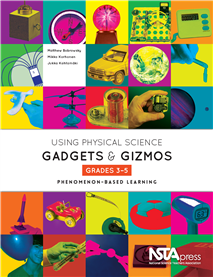Using Physical Science Gadgets and Gizmos in Elementary Grades
By Carole Hayward
Posted on 2015-02-08
 The authors of the popular Phenomenon-Based Learning series have released a new book geared toward elementary-age students. Using Physical Science Gadgets & Gizmos, Grades 3-5: Phenomenon-Based Learning is the latest book by Matthew Bobrowsky, Mikko Korhonen, and Jukka Kohtamäki. The activities they include are designed to building learning on observations of real-world phenomena—in this case of some fun toys or gadgets.
The authors of the popular Phenomenon-Based Learning series have released a new book geared toward elementary-age students. Using Physical Science Gadgets & Gizmos, Grades 3-5: Phenomenon-Based Learning is the latest book by Matthew Bobrowsky, Mikko Korhonen, and Jukka Kohtamäki. The activities they include are designed to building learning on observations of real-world phenomena—in this case of some fun toys or gadgets.
In the phenomenon-based learning (PBL) approach, students work and explore collaboratively: Exercises are done in groups, and students’ conclusions are also drawn in groups. “With the PBL strategy, the concepts and the phenomena are approached from different angles, each adding a piece to the puzzle with the goal of developing a picture correctly portraying the real situation.” In other words, it’s not so much a teaching method as it is a route to grasping the big picture.
The 30 PBL activities included in the book are divided into 8 main categories. Here are some examples of the fun you and your students can have while teaching and learning important science concepts:
- Speed: Using a Constant-Velocity Car, learn about constant speed, and measure some speeds with simple tools.
- Friction and Air Resistance: With an Air Puck, study how objects act if there is very little friction.
- Gravity: Using an IR-Controlled UFO Flyer, explore how gravitation tries to pull things toward the ground.
- Air Pressure: Using an Air-Powered Projectile, see the effect of gravitation and excess pressure.
- Electricity: With a Plasma Globe, explore electric charges and the phenomenon they cause called static electricity.
- Electric Circuits: Using a Hand Crank from a Snaptricity (a box of electric components that snap together for easy use), create a voltage just like a battery and light up a lamp.
- Magnetism: From the same Snaptricity box, take the compass and find out what it does when a bar magnet is brought close to it.
- Energy: Using a music box, explore moving energy with sound to learn what makes hearing possible.
The authors emphasize three reasons to buy this book:
- To improve your students’ thinking skills and problem-solving abilities.
- To get easy-to-perform experiments that engage students in the topic.
- To make your physics lessons waaaaay more cool.
Ordering information for all of the gadgets and gizmos used in the book is included. This book is also available as an e-book. Learn more about the other books in this series.
Disclaimer: The views expressed in this blog post are those of the author(s) and do not necessarily reflect the official position of the National Science Teaching Association (NSTA).


